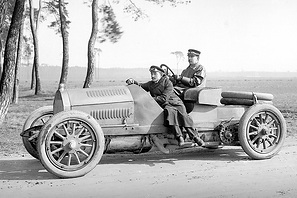While Daimler-Motoren-Gesellschaft (DMG) sped from success to success with its Mercedes racing cars, the trio of designers Fritz Erle, Louis de Groulart and Hans Nibel, newly installed at Benz & Cie. from 1904, struggled to catch up with their rivals from Untertürkheim. In 1904 and 1905 there was no factory involvement in motorsport and consequently no notable successes, but in 1906 a new high-performance racing car was developed whose design and technical specifications made it a serious competitor for the Mercedes.
The Benz 60 PS racing car was equipped with a slightly undersquare four-cylinder engine that produced a peak output of 60 hp/44 kW from a displacement of just over 8.9 litres. Power was transmitted to the rear axle by a 4-speed gearbox, which – in contrast to the Benz 60 PS Parsifal racing car – was not transmitted by a cardan shaft but by a chain on each side. Some sources also refer to the Benz racing car as 38/60 PS, with the first figure denoting the so-called taxable horsepower – a figure that was exclusively dependent on engine capacity and determined the amount of motor vehicle tax levied in the German Reich starting in 1906 and became a mandatory part of the type designation for production vehicles from 1909.
The car's first outing was the Targa Florio in Sicily in April 1907, a race held for the first time the previous year. It was named after its founder, the Sicilian businessman and landowner Vincenzo Florio, and was regarded as the most demanding and probably the most prestigious trial in motorsport at the time. The Benz team comprised three drivers: the equally experienced and fast Fritz Erle, Paul Spamann and Duke Clemens von Bojano. While Erle achieved the best individual result with the 60 PS racing car, finishing in 15th place overall after 9:11:15 hours – a rather disappointing result – the cohesive team performance was rewarded with the team prize in the "regularity" classification. Spamann in 17th place and von Bojano in 24th place had impressively demonstrated the reliability of their Benz racing cars on the punishing Madonie circuit.
After this less than spectacular first outing, the 60 PS racing car would go on to form the basis for further racing successes for the Benz team. It was equipped with a new engine which, after a reduction in displacement to just under 8 litres, corresponded to the so-called Kaiserpreis formula. The debut of the further developed 60 PS racing cars took place in June 1907, less than two months after the Targa Florio, at the Kaiserpreis Race, which was held over a distance of 117 kilometres in the Taunus range. Even though the Benz team had no luck, the Benz 60 PS racing car still achieved some racing successes in 1907.


